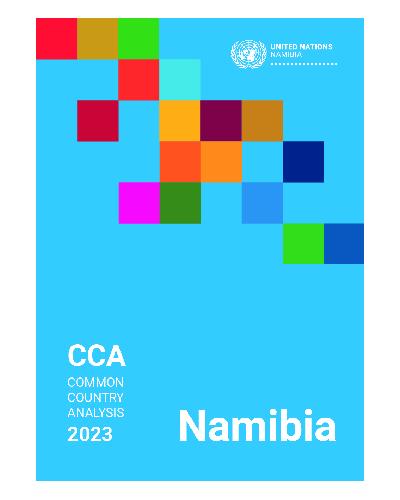Namibia’s Common Country Analysis (CCA) 2023

The year 2023 also marks the first ten years of the African Union’s Agenda 2063, a fifty-year implementation plan. This new generation of the CCA responds to the urgency of the 2030 Agenda for Sustainable Development by delivering integrated, forward-looking, and evidence-based joint analysis of the context for sustainable development in the country. The CCA provides tailored analysis at the country level, becoming the foundation for the design of the United Nations programmatic response through the Cooperation Framework.
The CCA, as an independent, impartial, and collective undertaking of the UN system, is based on two stages: first, assessment (i.e., a description of the country situation), and second, analysis (i.e., a description of causes and their implications) of the sustainable development situation in a country. It examines progress, gaps, opportunities, and bottlenecks vis-à-vis a country’s commitment to achieving the 2030 Agenda, UN norms and standards, and the principles of the UN Charter, as reflected in the Cooperation Framework Guiding Principles. The CCA draws from and adds to existing data, statistics, analyses, reviews, research, capacities, and resources from within and outside the UN system. These include national and sector-specific development visions and strategies, national budget allocations, and development financing from domestic and international, private, and public sources.
Namibia’s CCA has been developed based on the draft Roadmap for the CCA/CF 2024-2028, agreed upon between the UN Country Team and the National Planning Commission (NPC). The CCA was developed during the period from July to November 2022. The NPC has continued to be the coordinating body on behalf of the Government during the formulation of the CCA. The current Cooperation Framework Joint Steering Committee (JSC), co-chaired by NPC and the UN, has provided strategic direction for the roll-out and validation of the CCA, ensuring alignment with national development priorities. The assessment stage has consisted of a desk review of national strategies and plans, including the review of “Vision 2030,” the Harambee Prosperity Plan 2 (HPP2), NDP5 and its reports, and the SDG Voluntary National Reports for 2018 and 2021. Additionally, the UN Country Team has also integrated into the CCA analytical work, the preliminary framework of the NDP6, which is in its inception phase. Other strategic planning documents prepared or supported by UN Namibia were also used during the analytical work, including the Socio-economic Impact Assessment of COVID-19 (SEIAC), the Socio-Economic Recovery Plan (SERP), Development Finance Assessment Report (2019), the 2021 National Human Development Report, and the National Multidimensional Poverty Index (MPI) Report (2021), and other relevant sectoral documents.
In undertaking the analysis, the CCA utilizes a multi-pronged approach. First, a consultative and participatory process through UNPAF thematic groups and qualitative analysis utilising secondary data has been employed to identify the 11 development challenges and barriers in Namibia, and to present opportunities for SDG acceleration by the five inter-agency teams, as per the different dimensions (Table 1). Second, this has been complemented by quantitative analytical tools, including the macroeconomic forecasting model for Namibia, and the Climate, Land, Energy, Water Systems (CLEWs) model for integrated and forward-looking analysis, both developed by UNDS Inter-Agency Technical Teams under the leadership of the RCO for Namibia.




















